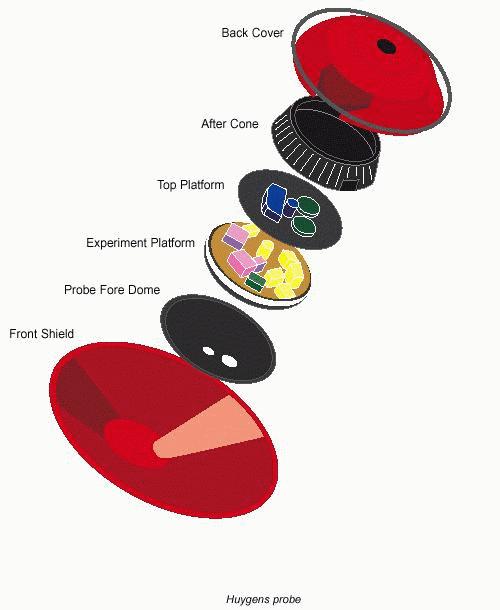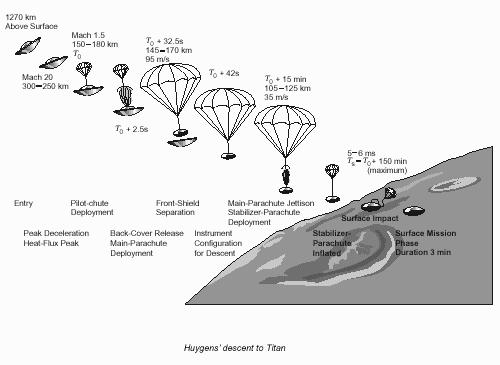
|
advertisement |

|
|
tell a friend!
software reviews bestseller list price survey what's new product support search educational tools ask a scientist math worksheets vocabulary builders hangman iPhone/iPad apps logic games brain food educational insights feature articles marketplace iPhone/iPad apps reading corner movie corner SuperKids home about SuperKids advertise! humor links help * * * Promotions * * * |
features > >
mission to Saturn > >
Huygens
The Huygens Moon LanderLaunched on October 15, 1997 from the Kennedy Space Center in Florida, the Cassini-Huygens probe took a very long and indirect path to reach Saturn. This path was necessitated by the heavy weight of the probe - over six tons, including propellant. Lacking a strong enough booster, NASA devised a tricky flight path that utilized the gravitational forces of Venus, Jupiter, and the Earth to create a series of "slingshots" to generate the necessary velocity to reach Saturn. After a nearly seven-year journey covering 3.5 billion kilometers (2.2 billion miles), Cassini-Huygens arrived at Saturn on July 1, 2004. 
The 320 kilograms (705 pounds) Huygens lander was built by the European Space Agency, and designed to enter and brake in Titan's atmosphere and parachute a fully instrumented robotic laboratory down to the surface. It was named after the Dutch 17th century astronomer Christiaan Huygens.  After spring-powered ejection away from the Cassini orbiter on December 25, 2004, the probe accelerated under the force of Titan's gravity toward the moon for 22 days. As atmospheric friction built up, the probe decelerated to about Mach 1.5, whereupon the aft cover was pulled off by a 2.6 meter diameter pilot chute. An 8.3 meter diameter main parachute was then deployed to ensure a slow and stable descent. The main parachute slowed the probe and allowed the heat shield to fall away when it was released. To limit the duration of the descent to a maximum of 2.5 hours, the main parachute was then jettisoned and replaced by a smaller 3.0 m diameter drogue chute for the remainder of the descent.
After spring-powered ejection away from the Cassini orbiter on December 25, 2004, the probe accelerated under the force of Titan's gravity toward the moon for 22 days. As atmospheric friction built up, the probe decelerated to about Mach 1.5, whereupon the aft cover was pulled off by a 2.6 meter diameter pilot chute. An 8.3 meter diameter main parachute was then deployed to ensure a slow and stable descent. The main parachute slowed the probe and allowed the heat shield to fall away when it was released. To limit the duration of the descent to a maximum of 2.5 hours, the main parachute was then jettisoned and replaced by a smaller 3.0 m diameter drogue chute for the remainder of the descent.
The Huygens probe was designed to photograph and perform much of its scientific analysis during this 2.5 hour descent. The duration of the observations and studies was constrained by two factors: (1) battery life, and (2) the time window within which the Cassini orbiter would be within range to receive and retransmit Huygens' findings to Earth. (Cassini would not come back into radio range for another 32 days). In addition to cameras, key study instrumentation included:
On January 14, 2005, the Huygens probe successfully descended to the surface of Titan. During its 2.5 hour descent, and almost 1.5 hours on the surface, the probe transmitted the results of its experiments back to Earth via the Cassini orbital spacecraft. Amazing photographs and telemetry data will be analyzed for years to come. return to top of page Questions or comments regarding this site? webmaster@superkids.com Copyright © 1998-2024 Knowledge Share LLC. All rights reserved. Privacy Policy |